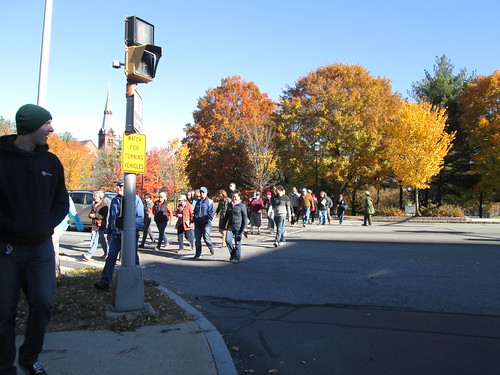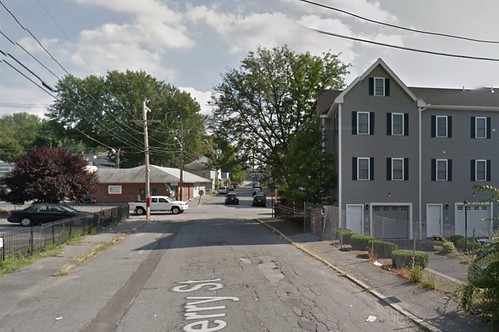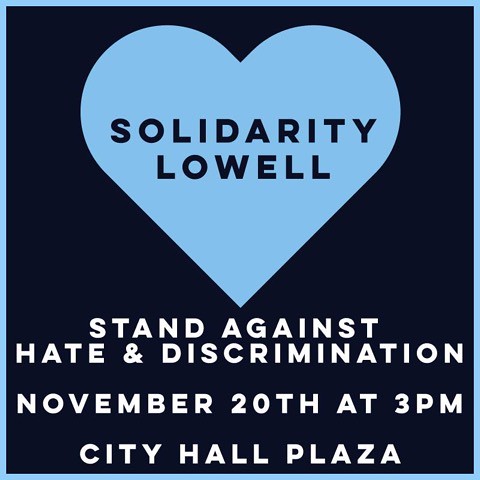Lowell Week in Review: November 20, 2016

Crossing Thorndike Street from South Common to Gallagher Terminal
Walkability
I often write about walkability. Making Lowell a more walkable city – and getting more people walking, biking, and using public transportation – would yield many benefits. Here are a few:
Economic Development
Last spring, GE (formerly known as General Electric) stunned many when it announced it was moving its corporate headquarters from suburban Connecticut to downtown Boston’s Seaport District. Yes, there were plenty of city and state tax incentives, but GE cited other reasons. According to Forbes,
[GE] wanted to move to a place that had a walkable urban environment and access to transit. GE also wanted to be in a vibrant, innovative environment that would be stimulating to workers. Boston certainly fits the bill.
GE’s move is as much a reaction to trends as it is a proactive measure. Why? Demographics. Young talent, particularly educated tech talent, is relocating as well. They’re moving to large cities, and jobs are following. Corporations want to be where the talent is. . .
Today’s educated young adults are attracted to cities by the things GE cites are reasons for its move — walkable urban environments that often stand in sharp contrast to their suburban upbringing; access to public transit that can make a car an option rather than a necessity; educational, entertainment and cultural amenities that add to the dynamism and vitality of cities.
Walkability is not a plot to outlaw the private ownership of motor vehicles. It’s an economic development strategy.
Traffic
I recently came across a 1973 state study on the proposed Route 213 which proposed a Lowell Connector-like highway that branched off Route 3 near the Drum Hill Rotary, then headed north, through Hadley Field with a bridge over the Merrimack River and Pawtucket Boulevard, then ending on Mammoth Road where West Meadow Road now intersects. The reason for this plan? “Extreme congestion occurs at all bridges in Lowell during the peak hours of traffic flow, and it is primarily this condition that the proposed project seeks to alleviate.”
That “extreme congestion at bridges” comment was written 43 years ago, but it sounds like something uttered at a recent city council meeting. Experience shows that widening roads and bridges does not reduce congestion; it does the opposite. It attracts more traffic. Recall how the widening of Route 3, last decade’s cure-all for traffic congestion, merely made two lanes of bumper-to-bumper traffic into three lanes of the same.
Urban planners today cite “mode shifting” as the best strategy for reducing traffic congestions. That means getting more people to walk, bike, ride public transportation, and to live closer to where they work. So if you feel frustrated by Lowell’s traffic jams, work to make the city a more walkable place.
Public Health
Not a lot needs to be said about this. Walking is good exercise and everyone would benefit from more of it.
Building Community
When you’re walking, you encounter your neighbors and others. You’re more likely to look at a window display, or spend money at a neighborhood business. You are able to admire the architecture of buildings, and the beauty of the landscape. In a car, you focus on not running into things while searching for a parking space, oblivious to all else.
Impediments to Walkable
The biggest obstacle to making Lowell a more walkable city is the absence of a shared vision of what Lowell should look like five, ten, twenty years in the future. We do have plans, Sustainable Lowell 2020 and Complete Streets to name two. They chart the course we should follow, but our elected leaders, even though they have voted for both plans, either ignore them or treat them merely as tickets to state money for road-widening projects.
So rather than follow an established plan that helps channel emerging opportunities into a widely shared vision of where the city wants to be a decade from now, we react to events as they happen.
Sometimes these reactions advance the cause of walkability, like three motions on this week’s council agenda:
- By Councilor Mercier, request City Manager find ways and means to illuminate the cross walk on Broadway Street in front of Senior Center with possibly reflectors or a solar light for vehicular and pedestrian safety;
- By Councilor Samaras, request City Manager invite members of the Lowell Parks & Conservation Trust to update City Council regarding the Concord River Greenway and its connections to other trails.
- By Councilors Leahy and Rourke, request City Manager explore possibility of reducing speed limits throughout the City, especially in densely populated areas, in accordance with the Innovative Cities Grant.
But sometimes the reaction casts aside walkability. Read my transcript of last Tuesday’s city council meeting for examples of that.
These are all difficult decisions that should be weighed carefully. Walkability should not have an absolute veto on a planned business expansion, but neither should the interests of the community automatically take a back seat to the will of a business, even when that business, as so often happens, says “give me what I want or I’ll move out of the city.” That’s why a long term plan with broad (and sincere) popular, governmental, and institutional support is so important. Then, when an opportunity arises, it can be measured against that long term plan. Does it advance the shared goals or will it create an obstacle to achieving them?
Western Ave Studios – Access Denied
Last week I wrote that the proposal to block the future River Meadow Brook Greenway with an expansion of the Gervais car dealership echoed the city council’s decision back in 1995 to close off Western Ave at Thorndike Street. Back then, what is now Western Avenue Studios was an automobile fabric manufacturing plant and the owner wanted the road closed at Thorndike Street, so the city closed the road. Now, the manufacturing plant is long gone and the building houses the largest collection of artists east of the Mississippi River. But the future viability of Western Avenue is threatened by the a railroad track that blocks pedestrians from walking the 75 yards from the Hamilton Canal Innovation District to Western Avenue Studios.
A report to the city council this week makes it clear that the blockage, in the form of an active railroad track, won’t be overcome any time soon. The report, in response to a motion by Councilor Leahy seeking a solution to this problem, states that the railroad refuses to grant a pedestrian crossing at grade and that a pedestrian bridge over the track would cost up to $6 million dollars and that “it is unlikely, given the existing prioritized transportation projects, that this project would be funded.”

Perry St looking towards Rogers. Condominium complex on right. Photo from Google Street View
Who Enforces Regulatory Board Orders?
At last week’s meeting, City Councilor Rita Mercier made a motion that the Traffic Engineer find a solution to the parking of cars on both sides of Perry Street near Rogers Street (see photo above). Here is what Councilor Mercier had to say on the floor of the council about this motion:
This is a safety issue. She says that when the condominium complex on that corner was constructed, it was supposed to have adequate parking for its residents onsite, but now all the residents park on the street. She adds that many times developers go before boards like the planning board, agree to conditions like onsite parking, get permission to build, sell off the units, then no one follows or enforces the limitations set by the city boards.
This is something I witness every day. Back in 2006, Drake Petroleum petitioned the Zoning Board of Appeals for permission to demolish the existing gas station at the corner of Elm and Gorham Streets and to replace it with a self-service gas station and convenience store. The Planning Board granted to petition but imposed ten conditions.

White SUV exiting gas station at Elm and Gorham Streets
One of those conditions was “Right turns only are permitted onto Elm Street.” The reason for that condition is pretty clear from the photo above. A car emerging from the Elm Street exit from the gas station intending to turn left towards Gorham Street would block the oncoming lane of traffic, just as the white SUV in the above photo is doing. When the gas station first opened, there was a bumper sticker-sized “no left turn” sign on a stick at the curb cut. That disappeared about a week later and has never been replaced. Drivers leaving the gas station routinely try to turn left, and routinely block traffic.
Maybe when the report on Councilor Mercier’s Perry Street motion comes back to the council, someone will ask who in city government is responsible for auditing conditions imposed by the city’s regulatory boards.

Solidarity Rally
A group of local residents has organized a Solidarity Rally today at 3 pm at Lowell City Hall. The purpose of the event is to show that “we stand against hate and discrimination.” Here’s what the group’s Facebook event says about the rally:
SCHEDULE:
3pm: PEACEFUL RALLY AT CITY HALL PLAZA
4pm: MARCH THROUGH DOWNTOWN
4:30pm: ARRIVE AT MILL NO 5, Floor 4 for an organizational meeting.
AT THE RALLY: We have lined up a few speakers, and will also intersperse those with open mic slots which you can sign up for at the rally. Max 5 minutes (roughly) per person – the more succinct you are the more people we can fit in to speak. Keep in mind there are likely going to be kids in the audience. Bring your signs – anti Trump signs are fine, but we hope you also think to bring signs that reflect the Event Statement above, to stand in solidarity with the entire community.
Library Event on the 2016 Election
The Pollard Memorial Library has organized an event called American Perspectives: A Community Conversation on the 2016 Election on Saturday, December 10, 2016 from 9:30 am to 11:30 am in the ground floor meeting room. Here is what the library’s website says about the event:
As we move past one of the most divisive presidential elections in modern US history, now is a good opportunity to reaffirm our commonalities as Americans and begin the work of bridging what divides us. It is in that spirit, especially as an institution dedicated to equal access to information and education, the Pollard Library is hosting a non-partisan, civil and constructive community conversation on the 2016 Election and its impact on America. We hope you’ll join local educators, community organizers, and fellow citizens on Saturday, December 10th at 9:30am. Everyone Welcome. Coffee and light refreshments served.
Building height has a lot to do with walkability. Anything over four stories casts persistent shadow and creates wind tunnels.
Thank you, Dick Howe!!! As always!!! :)
Walkability is certainly critical for quality of life and economic development. Thank you for laying it all out, again.
Thanks for the post on walkability! I have learned about the problem at Western Ave Studio from a colleague who live there. If building above the tracks costs too much, have the city considered going below (e.g. toward Wammesit Ct)? I know digging isn’t cheap but a walking/bike tunnel doesn’t need as much head room. What I saw in Davis, CA seems doable under $6 million, although I don’t know whether such design would meet the various codes.
Has anyone pointed out that the Gervais hard-line stance might be more about self-preservation than car storage? There’s much speculation that the auto industry could be headed for catastrophe in the next decade or so with the ubiquity of Uber and forthcoming autonomous car revolution.
Of course they would want to block a bike path that would help hasten their decline. Would you expect a 1970’s typewriter manufacturer to want Wang Laboratories to own land next to their property? Would Chelmsford residents who drive to work or school in downtown Lowell bike instead when the path gets built? Of course–not good for Gervais.
What’s crazy is that the city has the leverage over Gervais to say NO and it might not happen.
It’s nice that people are loyal to Gervais when buying cars but when consumers are presented with a better choice loyalty becomes irrelevant. Gervais knows this. How come our city leaders don’t?
Would reaching out to Cross Point executives make sense? They have bike storage and changing facilities. Isn’t in their interest to have the Freeman rail trail connect to downtown Lowell to better tap into that labor market and reduce parking maintenance costs? As more young educated people move downtown attracting them to suburban office parks is becoming difficult.